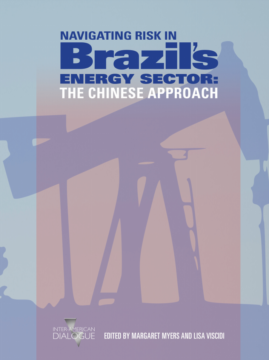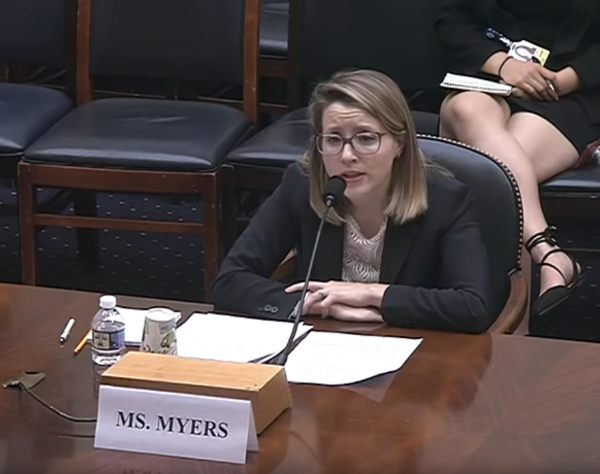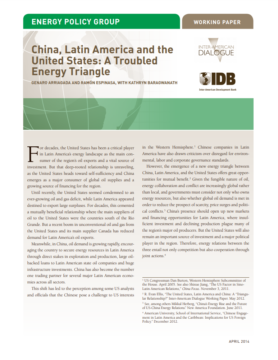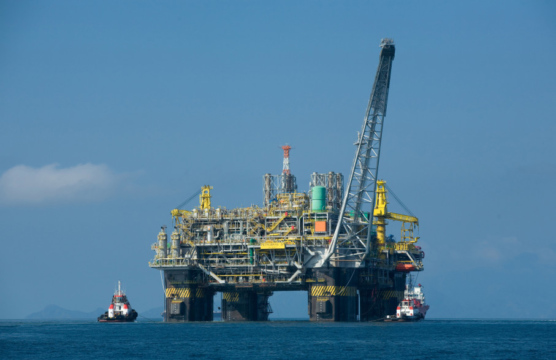
Navigating Risk in Brazil’s Energy Sector
Brazil’s oil and gas and electricity sectors are an important destination for Chinese direct investment.
I would like to thank Chairman Engel, Ranking Member McCaul, Subcommittee Chairman Sires, Subcommittee Ranking Member Rooney, and the other esteemed committee members for the opportunity to testify on the state of the China-Latin America relationship.
As China engages more extensively and with a wider variety of economic sectors in the Latin American and Caribbean (LAC) region, this is a critical moment to assess the type, scale, and effect of Chinese activity in LAC, and to formulate a well-reasoned US policy response. With this in mind, I offer a few thoughts, based on years of research and observation, on the ways in which the China-LAC economic relationship has developed over the past decade, is likely to evolve in the years to come, and implications for the US-LAC relationship.
1. China’s economic impact and influence varies considerably across countries and economic sectors in the LAC region.
Although Chinese companies, banks, and, increasingly, embassies are present in most every country in LAC, China’s footprint—and degree of economic influence, for that matter—is far more extensive in certain countries and economic sectors than others. China is arguably most influential, whether directly or indirectly, in those countries that depend extensively on its export markets or that have relied heavily on China’s policy banks—China Development Bank and China Export-Import Bank—as a source of finance.
Of all of the countries in the region, South America’s major commodity exporters have historically relied heavily on China as a destination for primary commodities. A 2017 study conducted by then economists at BBVA found that nine South American nations (in addition to Costa Rica) were highly dependent on China’s export market, and that the largest South American exporters had high dependencies in four commodities—soy, oil, copper, and iron ore. China accounted for almost half of Brazil’s total exports in 2017 and about 27 and 25 percent of Chilean and Peruvian exports, respectively. A considerable portion of Chile’s total copper production is destined for China in any given year, as are about 80 percent of Brazil’s soybeans. This level of dependency isn’t nearly as evident elsewhere in the region. China accounted for only about 2 percent of Mexico’s and El Salvador’s exports in 2017, by comparison.
Only a handful of LAC nations have relied heavily on Chinese state finance to date. Since 2005, approximately 93 percent of Chinese policy banks (China Development Bank and China Export-Import Bank) finance to the LAC region has been issued to just four countries—Venezuela, Brazil, Ecuador, and Argentina. This form of engagement has been in slowing as China’s state banks offer fewer and smaller loans on average to LAC governments and state-owned enterprises, but China still provided roughly $7.7 billion in finance to LAC governments in 2018, with Venezuela accounting for nearly two-thirds of that.
Chinese foreign direct investment is a less prominent feature of Chinese engagement with the region, but receives considerable attention nonetheless—due in large part to the massive scale of certain Chinese construction projects. Like Chinese finance, Chinese foreign direct investment in LAC is concentrated in specific countries and markets. For many years now, Brazil has been far and away the top destination for Chinese investors, having attracted US$19.5 billion in Chinese direct investment flows from 2014-2017, including flows through intermediary countries, according to the Central Bank of Brazil. Most of China’s still-limited private equity investment in LAC—part of a broader, global effort on the part of Chinese funds to diversify investment into growth industries in emerging economies—is also focused in Brazil.
Chinese investment is otherwise concentrated in a handful of industries across the region, including transport and other infrastructure and extractives. State Grid has established a remarkable presence in Brazil in just a matter of years, for example, with now-extensive investment in the country’s electricity grid. Chinese mining interests are evident in Argentina, Bolivia, Ecuador, Peru, Venezuela, and several other countries, whether in copper, gold, iron ore, and lithium. Two Chinese firms—Shougang Hierro and Chinalco—are actively growing their presence in Peruvian iron ore and copper mining, respectively, after years of operations there.
Aside from anecdotally, there are few clear examples of China exerting whatever economic leverage it may have in LAC for its benefit, whether successfully or not. But China’s relative importance as a trade and financial partner certainly has the potential to affect government-level decision-making vis-à-vis China. Some have speculated, for example, that China’s growing economic leverage in the region has been used to ensure that Chinese companies are awarded key contracts. In other cases, China’s influence is more indirect. Some have noted that Brazilian President Jair Bolsonaro’s hands are relatively tied as concerns China policy, for example, despite his critical stance on China while campaigning for the presidency. Brazil’s agricultural industry, which is strongly in favor of growing Brazil-China ties, features prominently among Bolsonaro’s political base. In likely recognition of China’s strong economic ties to their countries, Presidents Mauricio Macri and Lenín Moreno have both engaged rather extensively with China, despite their initial critiques of Chinese deal-making in Argentina and Ecuador, respectively.
China’s extensive relations with region don’t always guarantee support for Chinese objectives, however. Some LAC governments have been seemingly dismissive of China’s interests, and/or resistant to China’s preferred model of deal-making, in spite of growing economic and political ties. Despite a relatively high degree of trade dependency on China and its 2007 decision to cut ties with Taiwan, Costa Rica has carried out just a handful of projects in cooperation with Chinese partners. Only one major investment project—a highway expansion—has been initiated since diplomatic relations were established over a decade ago. Another major deal—to expand the country’s Recope refinery—was cancelled in 2016 following opposition from Costa Rican and other environmental groups.
Chile has also exercised considerable caution in its dealings with China despite a clear interest in growing the bilateral relationship. A Chinese-Chilean proposal for a high-speed train connecting Santiago, Valparaiso, and San Antonio has been under consideration for more than a year as officials evaluate the project’s public interest, feasibility, and likely environmental effect.
It is still too early to tell how Panama will approach its newly-established relationship with China. The country saw a boom in Chinese engagement following President Varela’s decision to cut ties with Taiwan, but most of China’s activity there, with a few notable exceptions, is in the form of construction contracts—not foreign direct investment or policy bank financing. And China’s trade with Panama is still quite limited. Panama isn’t excessively economically dependent on China at present, in other words, but certainly sees opportunity to advance infrastructure and other plans by engaging more extensively with Chinese entities. Chinese acquisition of more major logistical assets in the country or major Chinese financing for the Panama City-David railway could considerably alter the Panama-China dynamic.
2. China isn’t always successful in LAC, even in countries where it has relative “carte blanche.”
Chinese companies and banks have been granted considerable access and leeway in Argentina (under Cristina Kirchner), Bolivia, Ecuador (under Rafael Correa), Venezuela and elsewhere in the region, but even so face numerous obstacles to successful project completion.
The failure of Chinese companies to practice due diligence in the region has frequently led to unforeseen conflicts and resulting project delays or cost overruns. The examples are numerous, even in countries where China has considerable economic leverage and strong government-to-government relations. Sinohydro has reportedly struggled to complete the El Sillar roadway project in Bolivia, for example, forcing the government to recruit other companies to help with the project. A Chinese company’s failure to consult with affected communities derailed the Rosita dam project in Bolivia. Failure to consult local communities also halted a Chinese mining project in Ecuador. And a bullet train project in Venezuela was abandoned several years ago, after years of delays and cost overruns. Corruption allegations have also impacted Chinese projects in LAC, including a Querétaro railway concession in Mexico and two hydroelectric dams in Argentina.
Many of China’s proposed transport infrastructure projects never make it out of the planning phase. Of the about 150 transport infrastructure projects in which China has expressed interest since 2002, only about half had entered some phase of construction by the end of 2018. Many were cancelled or delayed indefinitely, or else are being studied by governments/companies or have yet to be awarded to specific developers. China’s major cross-regional infrastructure proposals in LAC, such as the Bioceanic Railway, which would run between ports in Peru and Brazil, haven’t moved far beyond the conceptual phase.
China’s major banks have also had a mixed track record in LAC. Although most of China Development Bank’s debt has been repaid by LAC governments, the financial institution stands to lose considerable money in Venezuela, the main LAC recipient of Chinese finance. Analysts have predicted Venezuelan default on oil-based payments to China as early as this year.
3. The China-LAC economic relationship is evolving rapidly, in ways that are both encouraging and troubling.
China’s engagement with the LAC region is still largely supportive of Beijing’s long-referenced “going-out” objectives, including securing access to raw materials, establishing new markets for Chinese exports, promoting Chinese brands, and internationalizing Chinese firms. But the ways in which China defines these objectives and its approach to achieving them has changed over time.
In some cases, the changes are mostly rhetorical. The Belt and Road Initiative (BRI) features increasingly prominently in Chinese policy toward the LAC region, but rather than replacing the decades-old “Going-Out Policy,” the BRI would mostly appear to support its main tenets. China continues its quest for raw materials, export markets, and investment opportunity for Chinese companies, but now with the BRI as an overarching framework. Officially extended to the LAC region in 2018, the BRI’s connectivity agenda envisions networks of cross-regional infrastructure that, if delivered, will (among other things) ensure more effective transport of primary commodities to port. Enhanced digital connectivity, another feature of the BRI, aims to advance Chinese telecommunications infrastructure and services in LAC and other regions, while also addressing global deficits in telecommunications connectivity.
Although China’s objectives in LAC are largely the same as they were about a decade ago, new, more strategic efforts to realize them could have concrete effects on the region’s welfare. Ongoing efforts on the part of Chinese companies to integrate more extensively across the region’s supply chains (in production, processing, logistics, and marketing) have left China with an increasingly dominant position in some of the region’s strategic sectors, for example, including agriculture in Argentina and energy distribution in Brazil.
China continues to view LAC as a critical export destination, just as it has for many years, but is now supplying the region with a very different set of products and services than it was a decade ago. Whereas Chinese exports to LAC used to consist primarily of low-value-added consumer goods, Chinese companies are increasingly selling a wide range of high-tech, high-skill products to the region, from rail carriages and ultra high voltage electricity transmission lines to cutting-edge telecommunications and surveillance equipment. Chinese goods, which often come at competitive prices, or with export financing, can be promoting of economic development in LAC by distributing much-needed electricity or connecting communities, for example. However, in other cases, their potential effect on democratic values and security in the region is of considerable concern. The possible implications of Chinese-made intelligent monitoring systems, variations of which have been implemented in Argentina, Bolivia, Ecuador, Panama, and Venezuela, are exceedingly troubling, for example. These systems are described by Chinese suppliers as promoting of citizen safety and security, but if used to exert social control (as they are in China or currently in Venezuela through the ZTE-backed “fatherland card”), can have critical implications for privacy and democratic governance.
Chinese investment and finance in LAC is also slowly diversifying, in ways that could be beneficial to the region. Chinese companies have supported local tech start-ups in LAC, for example, helping to boost regional innovation. China has also vowed to improve production capacity in LAC—some Chinese investment in regional manufacturing would appear to support this objective. Chinese private equity and portfolio investment is exceedingly difficult to track, however. So, for that matter, are the activities of Chinese commercial banks, which, among other functions, provide finance to Chinese companies operating in the region.
China’s economic activity in LAC is still mostly evident in extractive industries and infrastructure, however, with some troubling effects. Concerns have surfaced for years about export “primarization” in the region, the effect of extensive Chinese demand for just a handful of LAC commodities, and the environmental impact of Chinese projects, which are concentrated in environmentally impactful industries. There are also indications that LAC governments are weakening investment and other standards or disregarding existing regulations to attract Chinese and other investment or to facilitate cross-Pacific trade. This is especially the case in sectors—e.g., mining, oil & natural gas, and agriculture—in which Chinese firms are quite active. Examples include changes to Peru’s mining sector regulations, Argentine public works bidding processes (since reversed), and Ecuador’s removal of local partner stipulations in exchange for Chinese dam financing. A general lack of transparency in Chinese deal-making, especially for deals negotiated government-to-government, as China prefers to do, is also concerning and unlikely to lead to best outcomes in project development.
On the other hand, LAC governments and citizens would appear to be increasingly cognizant of the potential drawbacks of large-scale Chinese finance and infrastructure, despite growing, region-wide support for the BRI. Many in LAC view Venezuela and Sri Lanka as cautionary tales, having seen New York Times and other reporting on the latter. With these cases in mind, LAC governments and civil society will ideally be more attuned to the possibility of debt-related and other risks associated with no-strings-attached lending practices.
Also encouraging are efforts by some Chinese companies to embrace global standards for corporate social responsibility (CSR), the natural result, perhaps, of many years of “internationalization.” Chinese firms are generally regarded as being good at compliance when local regulations are clearly-articulated and well-enforced, but some Chinese companies have gone beyond what is required by the law to ensure smooth operations and good relations with local communities. Some have voluntarily adopted international corporate social responsibility standards, for example, such as those outlined by the United Nations International Organization for Standardization, to apply to their operations. This is especially true of companies, such as those in the mining industry, that are required, due to the nature of their work, to stay in a community for an extended period of time.
Chinese companies are also increasingly partnering with local and foreign firms and when striking deals in the LAC region, including in the infrastructure space. Chinese involvement in consortia made up of diverse partners doesn’t guarantee favorable outcomes but is thought to promote higher overall standards, including in the environmental and social realms.
4. The US can’t replace China in LAC, but can work to ensure best outcomes in the China-LAC relationship.
The US is right to worry about the implications of certain forms of Chinese engagement with the LAC region. Regardless of intent, some Chinese activity in LAC is potentially harmful to regional governance and stability. This is especially the case in countries with relatively weak institutional oversight and those without a strong and active civil society and media presence.
Like the US, many LAC governments are also aware of the challenges associated with China’s model of finance and investment. The region has taken stock of empty promises, projects-gone-wrong, and the problems associated with China’s model of large-scale, no-strings-attached finance. But LAC will continue to view China as an exceedingly valuable partner. After nearly two decades of enhanced Chinese economic engagement with the region, LAC governments and industries rely heavily on China’s economic activity, especially in those sectors where few other investors or banks are present. This dynamic is unlikely to change in the coming years, especially if BRI-type projects are extended to the LAC region.
The US has made some commendable efforts to boost US activity in key sectors to offer an occasional alternative to Chinese engagement. The BUILD Act will double the amount of US development finance that the US offers around the world, including for infrastructure development. And there are plans to leverage this financing in key markets in LAC.
But the US must also recognize that China plays a critical role in LAC that no other major partner (or group of partners, for that matter) can fill. As a result, an “us or them” policy will be viewed as unrealistic by most all governments in the region. In addition to growing its overall economic activity and outreach in LAC, the US must focus limited resources on strengthening governance, improving transparency, and fighting corruption in the region to ensure best outcomes for LAC and as level a playing field as possible for US and other companies. Cooperation with like-minded countries in the region and elsewhere in the world on the development and enforcement of rules-based trade and investment mechanisms will also be critical to ensuring regional stability and a strong and vibrant US-LAC relationship in the years to come.
Brazil’s oil and gas and electricity sectors are an important destination for Chinese direct investment.
The US’ standing as the main consumer of Latin America’s oil exports is unraveling as China emerges as a major consumer of global oil supplies.
Comparatively high rates of energy use in China and Brazil have led to investment in many forms of energy, including renewables.
 US House of Representatives
US House of Representatives

